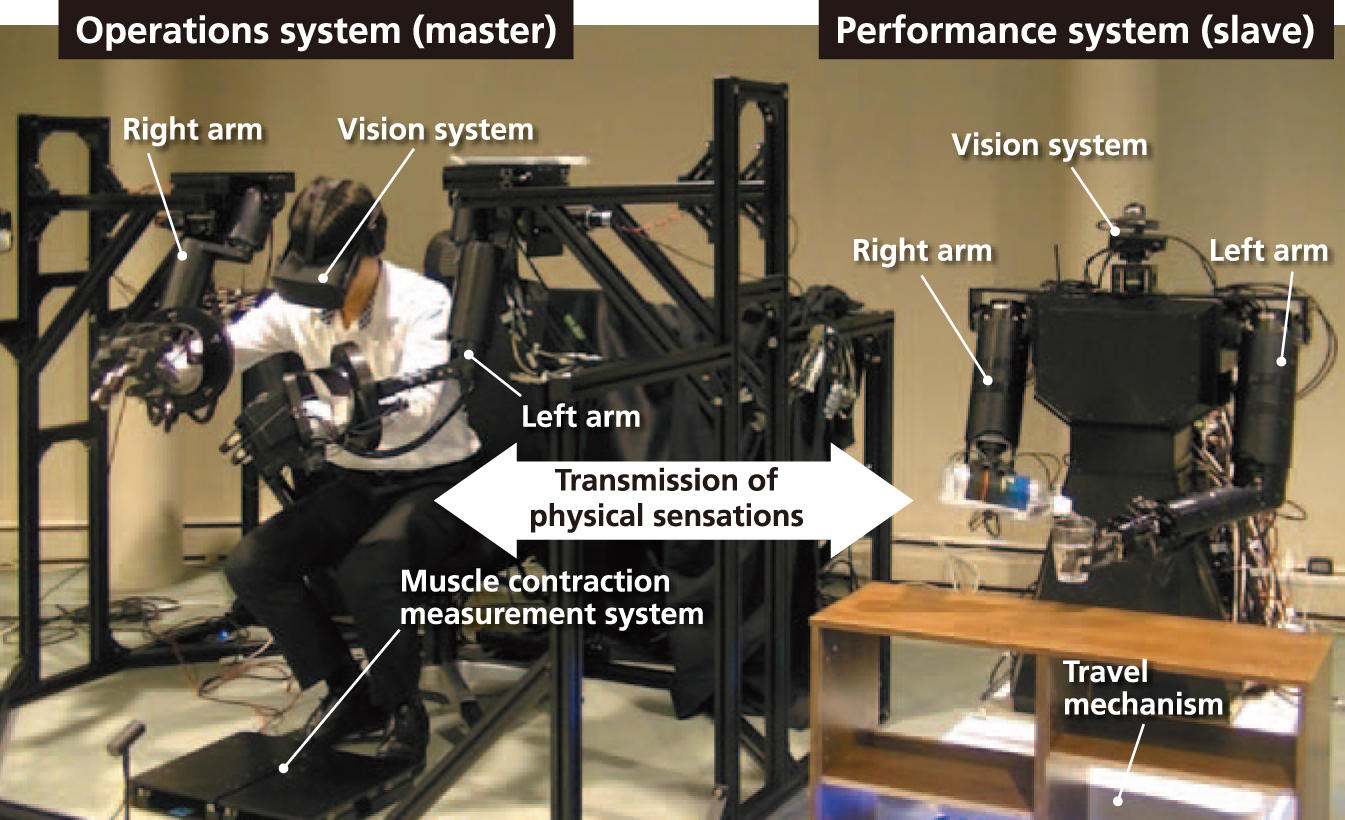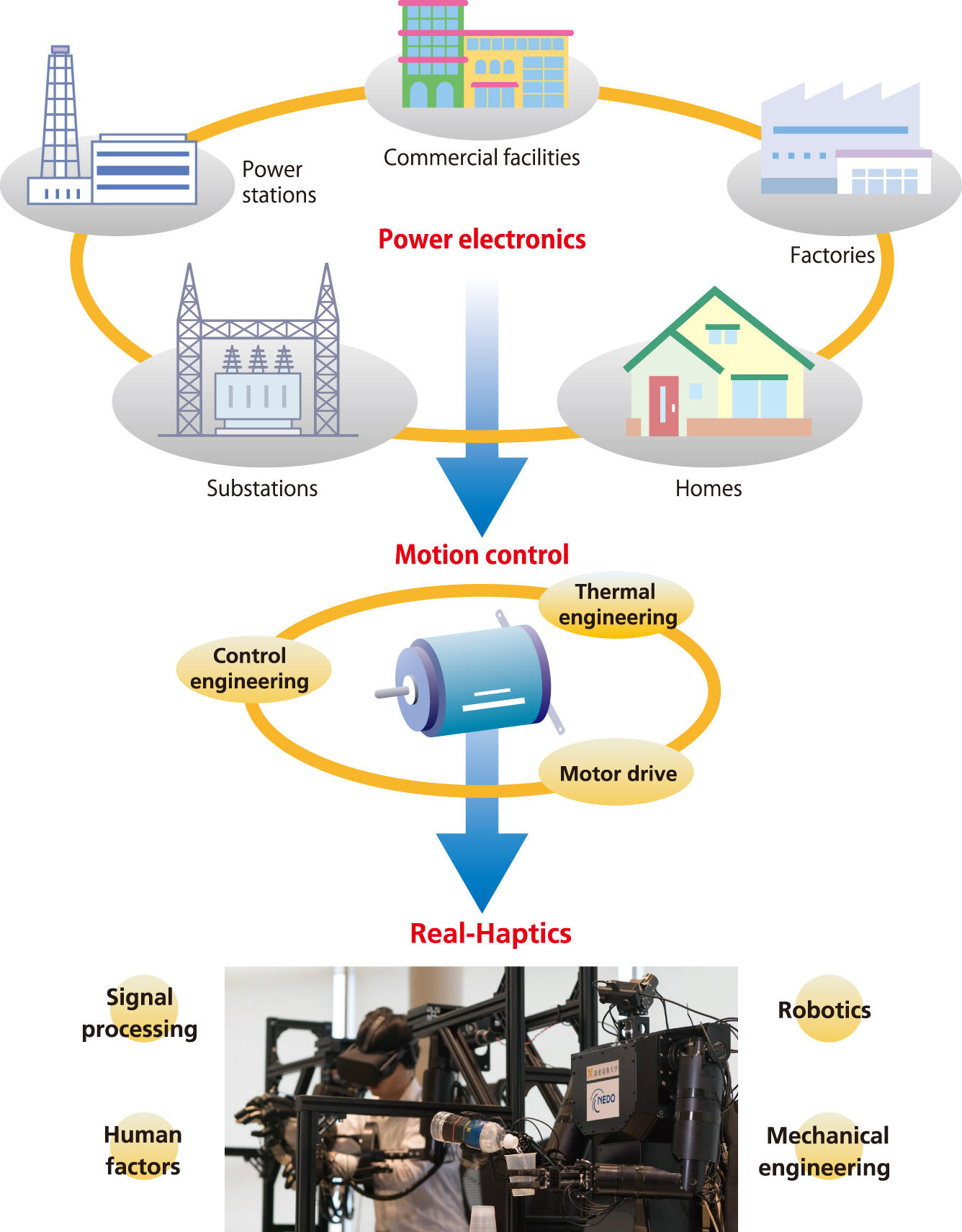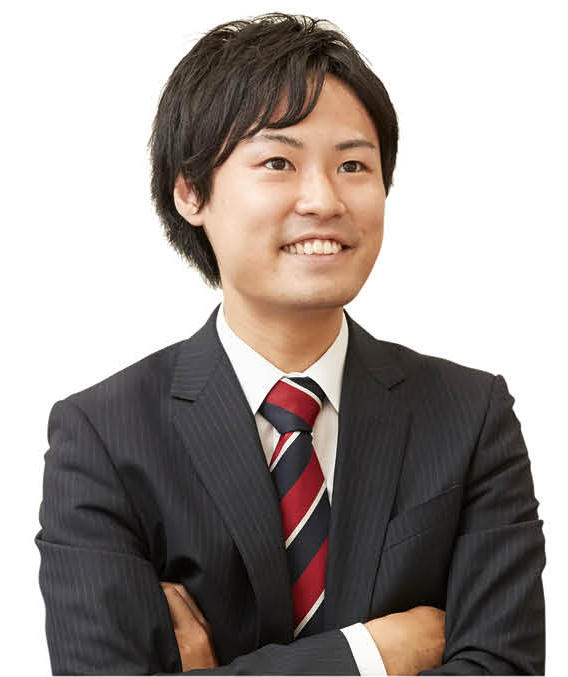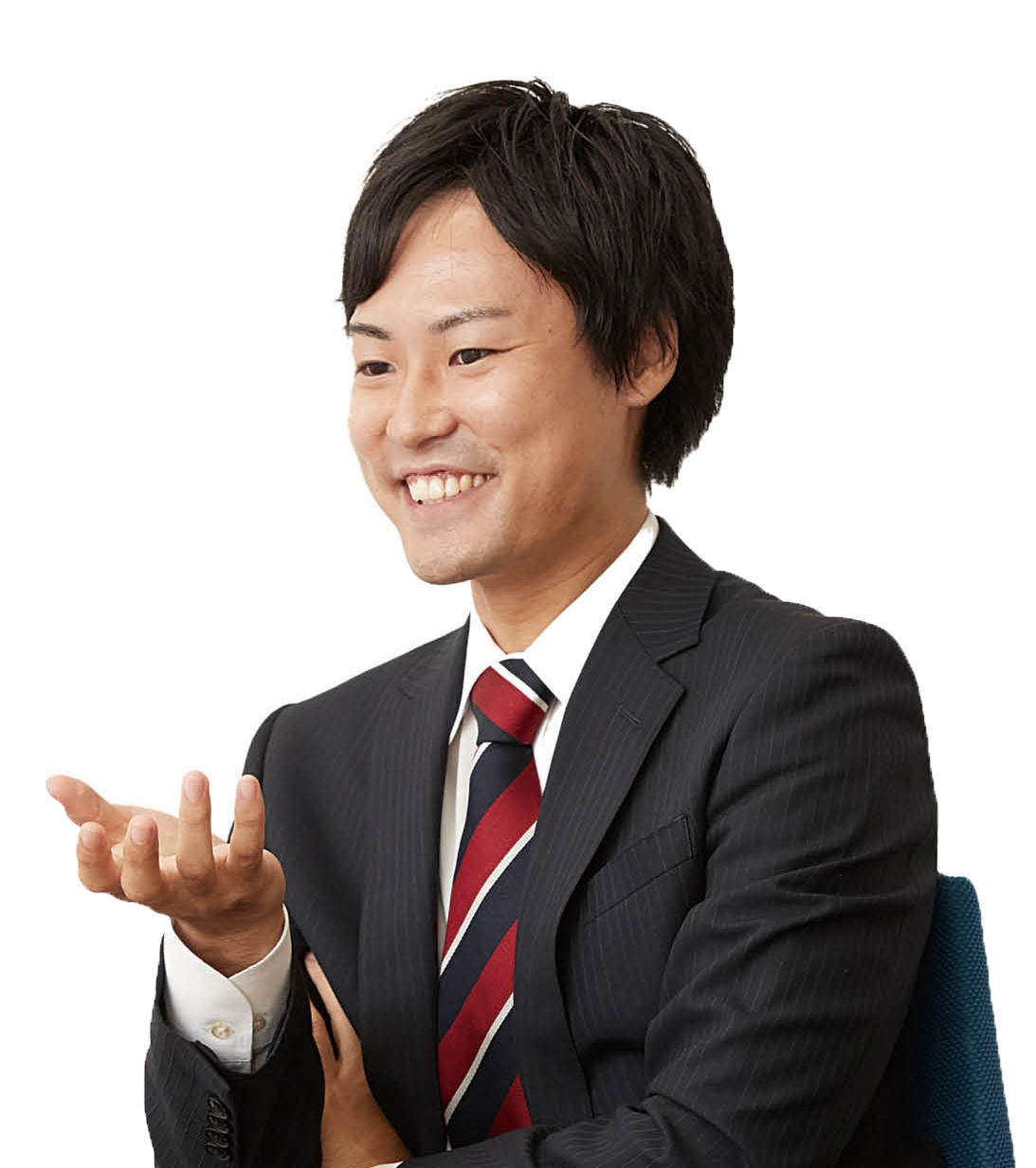- Home
- New Kyurizukai
- Electronical and Electronics
from Keio's Faculty of Science and Technology
Electronical and Electronics
from Keio's Faculty of Science and Technology
Moving the world through
the power of electricity
It is because no one knows the answer that in research you can confront and find yourself
If he had to choose between the “North Wind” and the “Sun” in Aesop’s Fables, Nozaki says that he is like the North Wind toward his students. He basically leaves them to carry out research on their own initiative because he believes that doing research and “having to really think about things” is an important experience for students who haven’t needed to do this before in order for them to confront and find themselves. What shaped his way of thinking can be attributed to his parents who raised an independently-minded child and a former teacher who prized individuality.
Takahiro Nozaki
Assistant Professor at the Department of System Design Engineering, Keio University Faculty of Science and Technology. PhD (engineering). Specializes in electrical and electronic engineering, control engineering, and robotics. Joined the Faculty of Engineering at the Yokohama National University as a research faculty member after finishing the doctoral program at the School of Integrated Design Engineering, Keio University Graduate School of Science and Technology in 2014. Became a Research Associate (non-tenured) at the Department of System Design Engineering, Keio University Faculty of Science and Technology in 2015, and has had his current position since 2018.
The Research
In this issue, we introduce Assistant Professor Takahiro Nozaki of the Department of System Design Engineering who has set his sights on a society in which people and robots can live side by side.
Towards the realization of a society in which robots are there for you
Real-Haptics and power electronics could be the key
“Robot development” is gathering much attention as a solution to the shortage of labor resulting from a declining birthrate and an aging population. However, for robots and people to live together, there are many technical issues that need to be resolved. Assistant Professor Nozaki is tackling these issues through the Real-Haptics technology he inherited from his former teacher, Professor Kouhei Ohnishi, and technology he himself is developing in the field of power electronics.
Long-awaited arrival of a dexterous robot
Doraemon is a robotic cat who aids a boy with various gadgets from the future. Many people probably watched the animation as a child. Doraemon’s birthday is September 3, 2112. Will such a robot be created in less than 100 years from now?
If you visit Assistant Professor Nozaki’s web page on the Keio University Faculty of Science and Technology’s Department of System Design Engineering website, a robot will appear at the top of the page (figure 1). The robot lifts up a plastic cup with one hand and pours water into it from a plastic bottle held in the other hand, following the actions of the operator in the operations system. I am astonished on seeing this, thinking “I’ve never seen anything like this!” Nozaki, who developed this robot, explains the reason why we are so amazed by this creation is because it is so dexterous. It doesn’t crush the soft plastic cup, and even as the weight gradually increases when the water is poured, it doesn’t drop it. Robots capable of such feats didn’t exist until now.
Robots up to now crushed blueberries when they tried to pick one up. Nozaki describes this as being “clumsy,” but it happens because without being able to sense that it has touched the blueberry, the robot can’t adjust the amount of force it needs to apply. Although not robots, the reason you will be seriously injured if you come into contact with an escalator or train is because the escalator or train cannot sense that it has touched you.

Fig.1: Robot with a sense of touch
The difficulty of acquiring a sense of touch
Robots that do the cleaning or guide people around facilities exist, but there are no robots that can perform caregiving duties. According to Nozaki, it is dangerous to use robots that can’t sense that it has touched something, and therefore robots that touch humans have yet to be introduced into our daily lives. So, how can a robot be equipped with a sense of touch?
First, consider the characteristics of tactile sensation. Touch is one of the 5 senses humans use to sense the environment around them. The other 4 are vision, hearing, smell, and taste. While these 4 are all passive, touch is an active sense that is capable of moving objects and changing the world around us. Therefore, if there are expectations on robots to take on the duties that have been carried out by humans up to now, such as supplementing the shortage of labor due to a declining birthrate and an aging population, they must acquire a sense of touch and be capable of adjusting the amount of force to apply.
However, it is not easy to create actions that adjust applied force with touch. This is because actions have both a hard and soft side. The hard side of touch is the property of always wanting to go to the set location whatever happens, while the soft side is the property that makes adjustments when something is touched and a force is felt. For existing robots that do not directly touch human beings such as industrial robots, actions must be accurate, and emphasis has always been placed on the hard side. However, to create actions that adjust applied force with touch, both properties must be combined. Yet, from the beginning, these two properties conflict, making the existence of the two together technologically difficult.
Nozaki’s former teacher, Professor Kouhei Ohnishi, made it possible to combine these two properties through the development of Real-Haptics technology. By measuring the amount of motion required of the motor to move the robot, and collecting data on the additional force required to move the motor when it touches something, it can sense how hard the object it came into contact with is. This groundbreaking technology also led to the creation of the robot introduced on the web page at the beginning of this article.
Studying power electronics to develop better robots
It is not easy to move robots in the way you want. Even to bend the arm, the motor at the joint must gradually accelerate, reach a constant speed, and then decelerate and stop, and this process of accelerating and decelerating must be performed smoothly. Robots will only begin to move when each of these individual actions work in harmony.
Ultimately, the motors that move the robots are powered by electricity. Therefore, Nozaki began to think that it is important to know how to use electricity to develop better robots. In 2014, he went to study power electronics under Professor Atsuo Kawamura at Yokohama National University for a year. Since returning to Keio University, he has been developing power electronics technology that he believes will become useful in the future.
The field of power electronics, which looks at electricity supply sources and the conversion of electricity with the aim of efficiently transmitting electrical power to users, has been studied for a long time.
Once electrical power became available, it was used to run motors, and then motor drives were created. Next, accurate motor rotations and the running of several motors simultaneously were pursued, leading to the birth of fields such as control engineering and robotics. In this way, new academic fields and technologies came into existence one after another in response to the needs of society. According to Nozaki, at the forefront of this is Real-Haptics technology (figure 2).
For a single robot to function, a wide range of academic fields including power electronics, thermal engineering, motor drive, control engineering, motion control, robotics, mechanical engineering, human factors, and signal processing must come together. The complexity and instability of society has increased considerably, making it difficult to deal with all of the problems that are seen today through traditional academic fields alone. This can be resolved through a systematic design approach, which can be learned at the Department of System Design Engineering.

Fig.2: Power electronics and robots
A future taking full advantage of touch and motion
Nozaki wants to continue to work hard in his research revolving around the two fields of “Real-Haptics,” which he inherited from his teacher, and “power electronics,” which he is advancing as a source of new strength in robotics. At the same time, however, he is working on product development with many industries to commercialize Real-Haptic technology. Currently, he is working with an airline to develop a system that enables people to experience fishing far away from the actual location without having to go there in person, while with a manufacturer of fruit sorting machinery, he is developing a fruit and vegetable sorting machine that will remove spoiled fruits without crushing them.
Just like making video and audio recordings to save and transmit what we see and hear, in the future, with the spread of Real-Haptics technology, it may become possible to save and transmit various movements and tactile sensations. What will the future be like then? Nozaki says that just like you wouldn’t prepare a boat and bring in actors and the director to watch the movie “Titanic,” you won’t have to wake up in the morning and make an omelet by yourself anymore. You will simply download the motion data to make an omelet from the internet and have a robot do it for you.
It looks like this technology will bring us a future beyond our imagination.
Interview
Associate Professor Takahiro Nozaki
When figuring out what I really wanted to do
Did you like robots since you were a child?
I often get asked this question. I feel that people expect me to say that I loved robots or that I spent a lot of time in Akihabara, but this wasn’t the case for me at all. But I loved Doraemon, and there is a picture of me looking very happy surrounded by Doraemon picture books (photo). It was from a time I have almost no memory of, so I am very grateful to my parents for taking this photograph.
If there is anything from my childhood that has a connection to what I am doing now, it would be an electronics project I did for homework over a summer vacation while I was in elementary school. I don’t remember enjoying it, but I was good at physics and I got good grades for it.
At any rate, I disliked teachers, and when I was in junior high and high school I would sometimes play truant. My mum and dad had a hands-off approach to parenting, so I didn’t really get in trouble. In fact, when I told them that I wanted to take an exam to get into junior high school because my friends were doing so, they told me not to bother.
I heard you intentionally gave up going to university before getting into Keio.
I was accepted into a university while I was in high school, but taking the university entrance exams got me thinking more about my future. I felt that I had to think properly about what I wanted to do and what will become necessary from now on, and to figure this out, I decided not to enter university immediately after high school and took a year out. It was during this time that I realized that I wanted to study robotics. To find out which universities had a strong control engineering program, a key area when developing robots, I read a book published by my cram school introducing the various faculties and departments of universities in Japan, and found out that Keio was first in Japan and ranked in the top 5 in the world. This was why I chose Keio.
However, once I entered university, I completely forgot about this, joined the tennis club, and enjoyed my student life. I went drinking with my friends and I married a girl who joined the tennis club when I was in my second year after dating her for about 10 years. But during the second half of my third year when we had to decide which laboratory to join, playing tennis started to feel meaningless. I had previously played various sports such as basketball and soccer, but in a way, these too had brought a sense of emptiness.
Thinking about life while researching robotics
day in, day out
You hoped to join Professor Kouhei Ohnishi’s laboratory when you had to choose a laboratory, didn’t you?

When we had to choose a laboratory to join, I remembered that I wanted to study at Keio to learn about robotics and applied to join Professor Ohnishi’s laboratory. I wrote my background and reasons for wanting to join his laboratory on an A4 sheet and went for my interview, and when Professor Ohnishi saw that I was from Nakano, he asked if I knew Nakano Ward Momozono No. 2 Elementary School. It turns out that we went to the same elementary school. After that, I talked a lot about our school. I didn’t talk about the research I wanted to do at the interview. I didn’t have good grades, and Professor Ohnishi’s laboratory was very popular so I was sure I wouldn’t get in, but surprisingly, he accepted me. Just before he left the classroom after the interview, Professor Ohnishi asked me if I had drawn lines before writing the document. To write documents neatly, I first draw lines on A4 sheets with a pencil, and after I finish writing, I erase the lines. Even though we didn’t talk about my research at all during the interview, he had read through my reasons for wanting to join his laboratory, and I realized from this that he was able to feel my motivation for applying. I was deeply moved.
What kind of laboratory was it?
He was like the North Wind in “The North Wind and Sun.” By this, I mean that in contrast to those teachers who really take care of their students, Professor Ohnishi was very hands off. It seems that he took this approach out of respect for the students’ individuality. I therefore don’t have much memory of learning about research from Professor Ohnishi. However, he gave us a lot of encouragement.
He once asked us to imagine seeds planted right in front of us. Then he asked what we think should be done to help the sprouts grow once they appear. He said that if you try to make the sprouts bigger by recklessly tugging at them, you will pull them up and they will die. For the sprouts to grow, they need sunlight, and you need to give them plenty of water and fertilizer. He said that if a teacher really wants the students to grow, the most important thing the teacher can do is to provide a suitable environment for them. I think I received just such an education.
Here’s another story. When he found me working late one evening, he came in and said he was leaving first. After a few hours had passed, I decided to take a break and went to make myself a cup of coffee. Beside the kettle, I found a cup noodle and on it was a post-it that said “midnight snack.” I thought he was a cool teacher with real flair.
He talked about “youth worries” too. He said that we may now be preoccupied with someone we like or our grades falling, but these are things that don’t matter to other people, and are what are called “youth worries.” According to him, real worries are those you have for others. However, he went on to say that only those who have thoroughly experienced such worries in their youth will be able to cope when faced with real worries, and that we should therefore embrace the worries of our adolescence. Thanks to these words, I have been to able overcome my worries many times since then.
Because this is the kind of teacher he is, whenever he says something, students expect it to be really important and listen attentively, even when he is joking. I have known him for many years now so I can tell when he is joking, but it’s funny watching the students’ reactions.
It’s fun to watch the students grow up
What kind of teacher are you?
Despite saying that I disliked teachers and their very existence, I chose to become one anyway. I also basically have a hands-off approach because I thought Professor Ohnishi was cool. However, there are students who develop more when given attention, so I try to adjust to the students’ needs.
I feel that students these days haven’t really thought about things for themselves. It can’t be helped because for high school tests and entrance exams, they only need to reproduce the answers they have memorized. But I feel they are still living according to the values that are held by the adults around them. Research is one way to break this habit. While studying new things without a single answer through research, students have to confront and find themselves. I think that it’s really amazing watching them grow up.
I’m going to mention Professor Ohnishi again, but he says that the great thing about being a teacher is that by the time you retire, of the 300 or so students you have taught, some will have become teachers or will be in a position where they have subordinates, and through these links, the impact that your daily activities can have on the future is considerable. For this reason, he says teaching is really rewarding. Now that I have become a teacher, I realize how true this is.
You seem to have had a lot of experiences, such as taking a post at Yokohama National University and setting up venture companies.

I wanted to study power electronics, so I got a post at Yokohama National University for a year. Professor Ohnishi preached that it only takes 3 seconds for the future to change, so opportunities must never be missed. These words gave me a push at that time too. Since coming back to Keio, I have been busy every day with supervising students, as well as putting my research outcomes to practical use and developing products with companies. In particular, there is a big gap between writing papers, the most important thing when doing research at university, and developing products that must make a profit, and I am realizing how hard it is to fill this gap with each passing day. Creating something meaningful for the world while writing papers and producing results is not easy. I always think that I need to remain strong to ensure I don’t cut corners in either task.
Keio University is where I decided what to do
in my life
What kind of place is Keio University for you?
In addition to students who entered the university through the general entrance examination, there are those who advanced from the affiliated high schools and those who came back to Japan after spending some time abroad, making Keio a university with a rich diversity of students who each have distinct personalities and academic abilities. Watching the students, I can see them mutually influencing one another while growing up. If they have a friend who is good at English, they try to improve their English as well, or if they see a well-dressed student, they also pay greater attention to their appearance.
My son was born in February this year. His name is Yoshihiro, written using the “gi” kanji character in Keio Gijuku, and the kanji for “hiro” from my own name. You may wonder how much I’m in love with Keio, but it is where I, who hated teachers, got my PhD and became a lecturer, which I never imagined I would be, so to me Keio is a place I cherish because it changed my life. I don’t want to go home before the students, but sometimes I go home early to give my child a bath. He’s very cute. The first stuffed toy I got for him was of course Doraemon. But I’m not trying to influence him to live the life I chose for myself.
I was so busy with work this summer that I wasn’t able to take a summer vacation, and although I didn’t have a fight with my wife, she took our son and went back to her parents’ home. I’m beginning to realize that spending time with family is necessary too.
Some words from Students
●At the interview, I was asked about my determination, to which I replied I will do my best. I’m interested in robots, and I also think this field will develop more in the future. (4th-year undergraduate student)
●I’m very satisfied because I’m allowed to do what I want to do. He’s very strict when it comes to doing research, but he is also someone who pushes me. If he’s not around, he is often in America or somewhere overseas. (1st-year master’s student)
●He’s so passionate about spreading robotic technology that it’s frightening. At his laboratory, you have to find on your own a research theme that should be looked at but no one is doing yet. I was once told that a theme I chose isn’t research. There were times when I was anxious, but carrying out the whole research process on my own has given me a lot of confidence. (2nd-year master’s student)
(Reporter & text writer: Akiko Ikeda)


